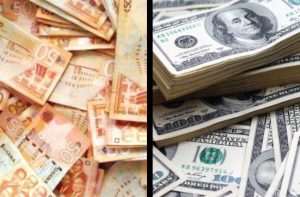
EIU predicts cedis rate to hit ¢7.87 by end of 2022.
London-based Economist Intelligence Unit (EIU) is expecting the cedi’s end of year rate against the dollar to hit ¢7.87 as captured in its April 13, 2022, assessment of the Ghanaian economy.
The expected depreciation of the local currency against the dollar for the next eight months of this year, according to the EIU, will be influenced by the import structure of the economy and some actions of the offshore investors in Ghana’s bonds
The EIU also adjusted its average end of year depreciation from ¢6.55 to ¢7.35.
Implications
Based on the forecast by the EIU, one can say the cedi’s worse and challenging depreciation against the US dollar is over.Some may also argue that the depreciation rate against the dollar will slow down significantly over the next eight months of this year.
This is because, based on the average quotes by some of the major commercial banks in the country, they are selling a dollar ¢7.80 to their retail clients.
The development may mean that for the next eight months, the cedi’s depreciation against the dollar may not be more than ¢0.7.
It may bring some comfort to businesses that had raised concerns about the sharp depreciation rate against the dollar in the past.EIU on cedi’s woes in the first quarter of 2022
The cedi weakened sharply in the first two months of 2022, reflecting increased demand for hard currency due to a strengthening in Ghana’s (structurally import-dependent) business activity and profit repatriation by Ghana-based multinationals (which is primarily carried out during the first quarter of the calendar year).
In a bid to stabilise the cedi, the Bank of Ghana announced foreign-exchange interventions, with $450m to be released via foreign-exchange forward auctions in the first quarter of 2022.
London-based Economist Intelligence Unit (EIU) is expecting the cedi’s end of year rate against the dollar to hit ¢7.87 as captured in its April 13, 2022, assessment of the Ghanaian economy.
The expected depreciation of the local currency against the dollar for the next eight months of this year, according to the EIU, will be influenced by the import structure of the economy and some actions of the offshore investors in Ghana’s bonds.
Implications
Based on the forecast by the EIU, one can say the cedi’s worse and challenging depreciation against the US dollar is over.Some may also argue that the depreciation rate against the dollar will slow down significantly over the next eight months of this year.
This is because, based on the average quotes by some of the major commercial banks in the country, they are selling a dollar ¢7.80 to their retail clients.
The development may mean that for the next eight months, the cedi’s depreciation against the dollar may not be more than ¢0.7.
It may bring some comfort to businesses that had raised concerns about the sharp depreciation rate against the dollar in the past.
EIU on cedi’s woes in the first quarter of 2022
The cedi weakened sharply in the first two months of 2022, reflecting increased demand for hard currency due to a strengthening in Ghana’s (structurally import-dependent) business activity and profit repatriation by Ghana-based multinationals (which is primarily carried out during the first quarter of the calendar year).In a bid to stabilise the cedi, the Bank of Ghana announced foreign-exchange interventions, with $450m to be released via foreign-exchange forward auctions in the first quarter of 2022. Some $300m had been released as of early March.
Regardless, strengthening growth will continue to reinforce import dependency, causing the cedi to depreciate on average over 2022.
EIU and Ghana Monetary Policy
The Unit said some further tightening by the Money Policy Committee of the Bank was needed to supply-side price pressures – including high utility and food prices, new taxes, rising global commodity prices and heightened freight charges, alongside supply-chain disruptions due to the Ukraine conflict, which are likely to keep inflation (especially fuel costs) elevated in 2022.
London-based Economist Intelligence Unit (EIU) is expecting the cedi’s end of year rate against the dollar to hit ¢7.87 as captured in its April 13, 2022, assessment of the Ghanaian economy.
The expected depreciation of the local currency against the dollar for the next eight months of this year, according to the EIU, will be influenced by the import structure of the economy and some actions of the offshore investors in Ghana’s bonds
Implications
Based on the forecast by the EIU, one can say the cedi’s worse and challenging depreciation against the US dollar is over.
Some may also argue that the depreciation rate against the dollar will slow down significantly over the next eight months of this year.
This is because, based on the average quotes by some of the major commercial banks in the country, they are selling a dollar ¢7.80 to their retail clients.
The development may mean that for the next eight months, the cedi’s depreciation against the dollar may not be more than ¢0.7.
It may bring some comfort to businesses that had raised concerns about the sharp depreciation rate against the dollar in the past.
EIU on cedi’s woes in the first quarter of 2022
The cedi weakened sharply in the first two months of 2022, reflecting increased demand for hard currency due to a strengthening in Ghana’s (structurally import-dependent) business activity and profit repatriation by Ghana-based multinationals (which is primarily carried out during the first quarter of the calendar year).
In a bid to stabilise the cedi, the Bank of Ghana announced foreign-exchange interventions, with $450m to be released via foreign-exchange forward auctions in the first quarter of 2022.
Some $300m had been released as of early March.
Regardless, strengthening growth will continue to reinforce import dependency, causing the cedi to depreciate on average over 2022.
EIU and Ghana Monetary Policy
The Unit said some further tightening by the Money Policy Committee of the Bank was needed to supply-side price pressures – including high utility and food prices, new taxes, rising global commodity prices and heightened freight charges, alongside supply-chain disruptions due to the Ukraine conflict, which are likely to keep inflation (especially fuel costs) elevated in 2022.Inflation We expect the headline inflation rate to remain high (averaging about 15%) throughout early 2022, driven by supply-side price pressures, including rising global oil and food prices—exacerbated by logistical bottlenecks related to the Russia-Ukraine war.—and high utility and transport costs.
Background
Average inflation will rise from 10% in 2021 to 13.4% in 2022 as prices for global commodities continue to increase, domestic demand starts to pick up further, and the currency depreciates sharply.
Inflation is forecast to average 8.8% in 2023-26, falling towards the lower end of the year.This will reflect monetary tightening and weakening supply-side price pressures as the forecast period progresses, in part offset by ongoing local-currency depreciation.
 Myjoyghana Best news and entertainment
Myjoyghana Best news and entertainment



